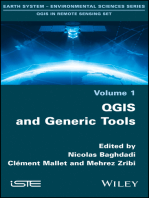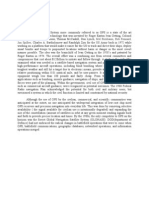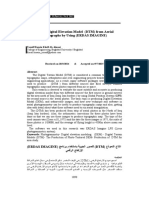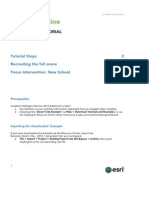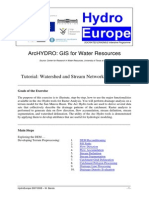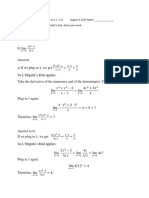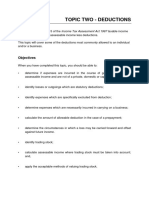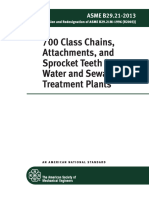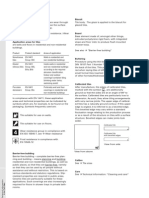Digital Terrain Analysis With Ilwis
Digital Terrain Analysis With Ilwis
Uploaded by
Victor OkechCopyright:
Available Formats
Digital Terrain Analysis With Ilwis
Digital Terrain Analysis With Ilwis
Uploaded by
Victor OkechCopyright
Available Formats
Share this document
Did you find this document useful?
Is this content inappropriate?
Copyright:
Available Formats
Digital Terrain Analysis With Ilwis
Digital Terrain Analysis With Ilwis
Uploaded by
Victor OkechCopyright:
Available Formats
Digital Terrain Analysis with Ilwis
DTA (Digital Terrain Analysis) is the process of quantitatively describing terrain. DTA is also known as geomorphological analysis, landform parameterization and land surface analysis. In this process the data is extracted from image maps that show the topography of an area. These maps are also referred to as elevation maps and a digital terrain model is also referred to as the Digital Elevation Model (DEM). DTM (Digital Terrain Modeling) is the process of creating DEMs. The following terminology is used consistently in the digital terrain analysis process: DEM Digital Elevation Map, i.e. representation of the Earths surface topography DTM set of techniques used to derive or present a DEM DEM filtering set of techniques used to improve the geomorphic resemblance of a DEM Terrain analysis or parameterization set of techniques used to derive terrain patterns from a digital terrain model. This is the process of quantifying the morphology of a terrain. Terrain analysis (DTA) is a general term for derivation of terrain parameters and their application Terrain parameters these are maps or images derived from a DEM using DTA e.g slope Topography or relief is the shape or configuration of the land, represented on a map by contour lines, hypsometric unit and relief shading
Terrain Analysis is accomplished by use of GIS packages like ArcGIS, IDRISI, ERDAS or ILWIS. In this application we will be using ILWIS. We will use ILWIS to run simple filter operations on already existing contour maps available for the different areas in this study.
Modelling Terrain
In modeling we will be creating DEMs from the contour maps of Nyadero, Nyabondo and Nyamarumbe locations. The contours maps for the respective areas are shown below:
FIGURE 1: NYADERO TOPO MAP
FIGURE 2: NYABONDO TOPO MAP
FIGURE 3: NYAMARUMBE TOPO MAP
These visualized data sources are already raster maps (images) where each pixel contains information on elevation or terrain parameter and other features evident like water bodies, settlement areas and vegetation. The contour lines provide information about the terrain of the respective areas. In modeling contour maps the technique used is called interpolation. Interpolation is the sampling of data at point locations or digitized from the contour lines. Interpolation is grouped into two where the interpolator can be exact or approximate or the interpolator can be local or global. For accuracy purposes, the grid size, scale and resolution must be taken into account. Generally an increase in the detail in the DEM will resolve to more accurate terrain parameters and in overall accurate results in quantitative data. In contour map data, the average grid size is determined by the length of the contour lines. In the above maps the grid sizes have been chosen with this fact in consideration and the limitation of the areas the study is focusing on. To give the data from the different a commensurate measure. A map with the greatest length of contour lines was chosen as a blue print for the rest of the areas. The largest grid area to work with should be at least the average spacing between the inflection points (a location at which the second derivative of a function changes sign i.e location at which
the second derivative changes from being concave to convex and vice versa). Theoretically speaking this is provided by the following formula:
However, in most scenarios we are greeted with the (chicken-egg problem) and in particular this study, we had to select the study areas and extract the grid sizes from a larger map. The grid sizes are hence chosen as an estimate. The grid resolution is given by the following formula:
The grid resolution should be at least half the average spacing between the contours, where A is the total size of the study area and l is the total cumulative length of all digitized contours. Incorporation of water bodies is a step in improving the geomorphic plausibility of the DEM. This is a step in DEM filtering which increases the accuracy of the quantitative data.
The Practical Guide on Creating a DTM
Creating a DTM in ILWIS implies (1) digitizing contour lines from existing topographic maps and subsequently (2) interpolation between the contour lines to obtain a rasterized surface of topography. The contours will be digitized from a segment map which contains coordinate data. Due to lack of proper digitized maps for analysis, the process of creating accurate DEMs involved use of other software applications like Golden Software Didger which provides a straight forward approach to digitizing the topographical maps. Once you have installed and started Didger, you can start a new project and import your image map. Next you will need to vectorize it using the tools available. The software will analyze the map and create polygon lines which in this case will represent the contour lines shown on the map. The following are the digitized versions of the above topographic maps.
FIGURE 4: NYAMARUMBE DIGITIZED CONTOUR MAP
FIGURE 5 NYABONDO DIGITIZED CONTOUR MAP
FIGURE 6: NYADERO DIGITIZED CONTOUR MAP
Calculating the slopes
With the digitization of the topo maps, we can now use ILWIS tools to enhance, filter and evaluate the data. In this step we will calculate the slopes in each and every one of these maps and find out the coverage of high altitude terrain and how they affect population, vegetation coverage and water bodies present in the areas. It is common knowledge that high altitude areas are usually a source for water bodies (rivers and streams), as it is evident in the digitized maps the points marked in blue represent water bodies. In ILWIS, slope and aspect are calculated using the gradient of the slope, calculated from the DEMs at each pixel. The filters Dfdx and Dfdy are gradient filters in the X and Y coordinates respectively that yield the altitude differences in these directions on a pixel by pixel basis.
Calculating the slope is a two-step process: first the two filtered maps for the gradient in X and Y direction are calculated and used to obtain slopes: 1. Select from the main ILWIS menu the options: Operations, Image Processing, Filter. Select the filter Dfdx and the map. The output is dx 2. Repeat the procedure for filter Dfdy. Output is Dy. 3. Type the following formula on the command line of the main ILWIS window to create the map Slope
Slope = ((hyp(Dx,Dy))/50)*100
4. Display the slope map on the screen and overlie the fault pattern. You should see the above patterns.
Green Vegetation Indexing
To determine the vegetation coverage we will use the green vegetation index. The most used vegetation index is the Normalized Difference Vegetation Index (NDVI) defined as:
NDVI = (TM 4 TM 3)/(TM 4 + TM 3)
The NDVI is calculated using the NDVI function NDVI = NDVI (TM3, TM4)*127+128 in ILWIS. This command is input in the ILWIS command line and pressing enter then selecting the image map. TM3 and so on represent areas of high threshold color composition representing the vegetative areas. This technique however was not applied to this situation since the topographic maps do not have areas of high threshold to represent the vegetative areas. We will therefore assume that the lack of the vegetative regions means that these areas are bare or have very little vegetation, which could not be digitized.
Analysis of the Data Collected
From the data collected from the initial topographic maps through the process of modeling and generation of digitized contour maps we can conclude that the presence of water bodies are determined by the presence of high altitude areas. In areas like Nyamarumbe which is mostly a low altitude area does not have any water bodies present, if any then they are just secondary water bodies which dry out in times of low rainfall. It is also evident from the topographic map
of this area that human population is higher here. This is in comparison to the higher altitudes of Nyadero and Nyabondo areas. Even though digitization of Nyaderos topographic map did not reveal any vegetative areas. It is evident through basic map reading that the high altitude of this area has a high vegetative cover with very minimal human settlement. Settlement is concentrated in the lower areas of the map.
Modeling Land Use and Land Cover Change in Nyakach
Before one can start any analysis on image maps they must be matched to a coordinate system. The georeferencing process matches features in your scanned map image to real world coordinates on the ground. An example of reference systems are Longitude and Latitude, Universal Transverse Mercator (UTM) and State Plane Coordinate System. If you have specific geospatial data you want to use, then it would be best to reference your image to the coordinate system of your data. Finding Ground Control Points (GCPs) To georeference an image you need GCPs which are visible in the photographs. Some examples of good GCPs are road intersections, stone wall boundaries, building corners, and solitary trees. These points will be used to tell the GIS software: where your image is in the world how to correctly orient the photograph correct for errors in photo-geometry.
These errors are probably caused by the inherent problems of taking aerial photographs, such as airplane tilt and problems with the lens. The better your GCPs the better your resulting image will be referenced to the real world. The number of GCPs you choose will depend on the amount of distortion in your photograph and your desired level of accuracy. The process of registering your photograph applies a mathematical formula to each pixel in the photo. The process of rectification can be thought of making a regression equation that says where a image coordinate corresponds to real world coordinates. The simplest formula is a linear equation, which does not distort the picture but cannot correct any photo-geometry distortion except for skew. Higher order (more complex) equations can correct more serious cases of photo-geometry distortion but they can also seriously distort your final image. As you make the equation more complex you have to add more GCPs. A linear equation requires a minimum of 3 points, a second-order equation requires 6 points, and a third-order equation requires a minimum of 10 points. In general you should find at least double the number points so that you can discard bad points and you can also lower the error in fitting the equation.
At the map library we have a collection of maps called USGS Topographic Quadrangle Sheets (quad sheet). These maps cover the entire U.S. at a scale of 1:24,000. By using a coordinate grid and a quad sheet, you can get coordinates for GCPs in Lat/Long, UTM, and State Plane. The map library has a reference map for New England which gives the name for the quad sheets. Once you have your quad sheet(s) you can put the coordinates into a GIS and georeference your image. To learn how to get coordinates off a quad sheet please read: CHOOSING GCPS and READING COORDS OFF A COORDINATE SHEET. Getting the coordinates into a GIS The first step in georeferencing your image is to open a Correspondence File. This file will be used by Idrisi to reference your image. The best idea is to call the file <YourImageName>.cor, where YourImageName corresponds to the name of your scanned image. Open the Windows Notepad (or any ASCII text editor). The format of the file is as follows 5 65 4225 429043 460102 538868 501868 597383 541801 449235 527318 492297 425079
1702 1657 3424 4470 2605 3199 5951 1782
The first line of the file denotes how many GCPs there are in the file (5 in this instance). The following lines are:
originalX originalY newX newY
Where the original X and Ys correspond to the column and row numbers of the GCP from the photograph after it has been imported into Idrisi. The new X and Ys correspond to the coordinates for the same GCP read off the quad sheet (CT State Plane in this instance). Save the .cor file and begin the Idrisi RESAMPLE module. This process will put your photograph into real world coordinates.
A prediction methodology using Markov-Cellular Automata Model
Land cover change models have been developed for predicting landscape change at different levels of complexity. Most techniques predict future scenarios based on the logistic regression, multi-agents and cellular automation. Prediction models can also be viewed as either stochastic or process based. Stochastic models include Markov, Cellular Automata and Logistic Regression, while process based models include the dynamic eco-system model. These spatial models consist of three components: multitemporal maps, a transition function, and a simulated map of future land cover changes. The Markovian Cellular Automata model has gained standing as one of the most powerful means of projecting land use/cover trends.
Markov Cellular Automaton modeling of land use/cover changes A Markov-cellular automaton is a robust spatially explicit hybrid model which integrates the Markov Chain Analysis and Cellular automata and is an improvement in spatio-temporal dynamic modelling. The integration of the Markov process and the cellular automaton mechanism offers significant modelling advantages. Whereas the Markov process directs temporal dynamics among the land cover classes by means of transition probabilities the cellular automaton mechanism addresses the local rules relating to neighbourhood configuration. In tandem with the transition probability, it determines the spatial dynamics of land cover types. Although the Markov chain analysis operates under fairly restrictive assumptions such as independence and stationarity, it is mathematically easy to implement. In addition, the land use/cover transition probability results can serve as an indicator of the direction of land use/cover processes. Deficits in the Markov Analysis are compensated through the integration of the cellular automata, which facilitates the spatial interactions of the land covers through proximity modeling. Data and methodology The datasets used for predicting the land use/cover changes include land use/cover maps previously generated for Nyadero, Nyabondo and Nyamarumbe areas from satellite maps images for the respective areas. The 1960, 1970 and 2010 classified maps were used for the projection to 2019. 2030 and, 1997. Idrisi Andes software was used for performing the Markovian Cellular Automata model and model validation. This remote sensing and GIS software was selected for its advanced environmental modeling capability. Idrisi has both GIS, IPS as well as advanced modeling functions including: Land Change Modeling Earth Trends Modeling Markov Analysis and Markov Analysis combined with Cellular Automata
Markovian simulation The Markovian Cellular Automata model was implemented to predict land use/cover changes in this study. This model was chosen based on its simplicity to implement in a GIS environment. Markov Chain Analysis is suitable to use when changes and processes in the landscape are complex to describe. A Markov process is defined as one in which the future state of a system is projected entirely on the basis of the immediately preceding state. The process involves computing the transition probability matrix of land cover change from time one to time two, which is then considered to be the basis upon which to assign to a later time period. In this study, the Markov chain method was implemented to analyse the 1966 and 1974 pair of classified images and to generate a transition probability matrix, a transition area matrix, and a set of conditional probability maps. A transition probability matrix indicates the probability of inter-class transitions among different land use/cover types, while a transition area matrix shows the quantity of land that is expected to transform from one class to another over a 13 year period (up to 2019). Conditional probability images show the probability of existence of a particular land use/cover type over the 13 year period; these images are computed as temporal projections based on the 1966 and 1974 input land use/cover images. The 1966 and 1974 classified maps were used as the earlier and later land cover images respectively. The prediction is purely based on the state of land cover in 1966 and 1974; the background cells were assigned a value of 0.0. A proportional error of 0.11 was assigned to the prediction based on an overall accuracy of 89% for 1974. Land use/cover is considered to be temporally persistent over 10-15 year intervals (Lambin et al., 1999; Gmez-Mendoza et al., 2006), thus a 13 year prediction used in this study was within the required range. A summary of the computations involved in the Markov projections is shown below, where land use/cover is considered as stochastic process of which the different classes are regarded as the states of a chain. A Markov chain is expressed as follows:
(1) If a Markov sequence of random variable Xn takes the discrete values a1 ....a N, then
(2)
Where the sequence X n is called a Markov chain. The initial transition area matrix of the different land use/cover classes is shown in expression.
(3) Where Xij indicates the quantity of land use/cover type i transforming to land use/cover j over a particular period of time, n denotes the number of land use/cover types. This calculation simplifies to:
(4)
(5) Pij shows the ratio of the quantity of land use/cover type i transforming into the land use/cover class j in the period of time. Using the equations of the Markov process and Bayesian principles of conditional probability, the above equations are further simplified to.
(6) Where denotes the area of land use type j at the kth state.
Integration of the Markov Chain analysis and Cellular Automata Markov Chain analysis results were further processed using the Markov Cellular Automata algorithm to bring a spatial sense not considered in the Markov Chain projection. The Markov Cellular Automata function integrates the Cellular Automata, Markov Chain and MultiObjective Land Allocation which takes consideration of spatial contiguity and a sense of the likely spatial distribution of the transitions to Markov chain analysis. The 2006 land cover classification was used as a basis land cover image for change simulation. A transition area file derived from the Markov Chain analysis was incorporated into the Markov Cellular Automata
computation, which determines the quantity of potential land allocated to each land cover class over a 13 year period. A 5x5 contiguity filter shown in equation (7) was chosen for the cellular automata. The filter down-weights the suitability of pixels that are far from existing areas of each land cover class.
(7) The role of the contiguity filter is to ensure the ideal choices for land cover transformation are restricted to cells that are both inherently suitable and in close proximity to existing areas of that land cover class; this gives preference to contiguous suitable areas. A total of 13 iterations were used in the simulation. The multi-objective land allocation (MOLA) procedure was used in each time step to resolve the land allocation conflicts. All land use/cover classes act as claimant classes and contend for land within the host class. Results Predicted land cover transformations from 2006 to 2019 Transition probabilities and areas tables are shown in Table 1 and Table 2. The transition probabilities indicate a probability of 0.4474 for vegetation to remain in its current state and a probability of 0.5132 for vegetation to transform to degraded vegetation. The conversion of vegetation to degraded vegetation state is accompanied by an area migration of 455.036km2. A lower probability of 0.0195 is associated with direct vegetation migration to bare and degraded soil, accompanied by a transition area of 17.262 km2. A probability of 0.0488 and a transition area of 74.179 km2 is associated with a further degradation of degraded vegetation into bare and degraded soil. A higher probability of 0.4889 exists that bare and degraded soil will recover to degraded vegetation with area coverage of 35.222km2. Probabilities of 0.2343 and 0.179 exist for bare and degraded soils and degraded vegetation respectively to recover to fully vegetated areas with transition areas of 16.884 km2 and 271.991 km2 respectively associated with the recovery. The change detection matrix statistics in Table 3 reveal that 23.576% of the vegetation cover will transform to degraded vegetation, whilst a mere 3.217% of degraded vegetation is going to recover to full vegetation cover. A further 8.147% of degraded vegetation will degrade to bare and degraded soil whilst only 3.62% of bare and degrade soil will transform to degraded vegetation.
Table 1 Land use/cover transition probabilities, 2006-2019.
Probability of changing: 2019: Vegetation 2006: Degraded Vegetation 0.179 Bare and Degraded Land Vegetatio Degraded Vegetation Bare and Degraded Land n 0.4474 0.5132 0.0195 0.612 0.4889 0.0488 0.0283 0.2343
Table 2 Land use transition area matrix (in km2) 2006-2019.
Expected transition: 2019 Vegetation Vegetation 2006: Degraded Vegetation Bare Degraded Land 396.7236 271.9908 16.884 Degraded Vegetation 455.0364 929.6919 35.2224 Bare and Degraded Land 17.262 74.1789 2.0421
A net decrease of 17.993% was recorded for vegetation. Significant increases of 78.46% and 52.841% were projected for settlement, bare and degraded land whilst a marginal net growth of 0.0115% for degraded vegetation is predicted. The change detection statistics confirm considerable degradation to bare and degraded soil and conversion of vegetation to settlements. Although a minor net change in degraded vegetation is predicted, examination of the change detection matrix reveals that important land use/cover class interchanges are concealed by viewing the net changes per land use/cover class alone. The changes in degraded vegetation are characterized by significant losses to bare and degraded soils which are compensated by gams from intact vegetation; such a scenario indicates an increase in land degradation.
You might also like
- Formwork A Practical GuideDocument447 pagesFormwork A Practical Guideraahul_n86% (7)
- POSPac MMS Geoid Converter User ManualDocument10 pagesPOSPac MMS Geoid Converter User Manual渕上翔No ratings yet
- Intro DTMDocument5 pagesIntro DTMHardi Abu KhaleedNo ratings yet
- Edition - 2013 - Encyclopedia of GIS (3) - Annotated PDFDocument2,504 pagesEdition - 2013 - Encyclopedia of GIS (3) - Annotated PDFXaviier PerezzNo ratings yet
- PIX4D Simply PowerfulDocument43 pagesPIX4D Simply PowerfulJUAN BAQUERONo ratings yet
- Passive Remote Sensing: Allocations, Sensors, Measurements and ApplicationsDocument34 pagesPassive Remote Sensing: Allocations, Sensors, Measurements and ApplicationsAndrea DeleonNo ratings yet
- Atlas of Europe PDFDocument26 pagesAtlas of Europe PDFManea RaduNo ratings yet
- Syntax2d ManualDocument18 pagesSyntax2d Manualkhaled_ezzatNo ratings yet
- Orthorectification Using Erdas ImagineDocument14 pagesOrthorectification Using Erdas ImagineArga Fondra OksapingNo ratings yet
- Computer Processing of Remotely-Sensed Images: An IntroductionFrom EverandComputer Processing of Remotely-Sensed Images: An IntroductionNo ratings yet
- History of GPSDocument15 pagesHistory of GPSMiguel FairmanNo ratings yet
- Quantum GIS (QGIS) Raster Based Terrain Analysis TechniquesDocument7 pagesQuantum GIS (QGIS) Raster Based Terrain Analysis TechniquesAna-Maria CiobotaruNo ratings yet
- WebMapping CHAPTER 1Document11 pagesWebMapping CHAPTER 1helmy mukti100% (1)
- Dem Erdas ImagineDocument11 pagesDem Erdas ImagineMohannad S ZebariNo ratings yet
- Building Web Based Gis Applications With GeoExtDocument10 pagesBuilding Web Based Gis Applications With GeoExtgerardoarielcNo ratings yet
- Free and Open Source Web MappingDocument0 pagesFree and Open Source Web Mappinglot4No ratings yet
- Desert City Tutorial PDFDocument7 pagesDesert City Tutorial PDFMotaz ElMasryNo ratings yet
- What Is GIS?: - A TechnologyDocument36 pagesWhat Is GIS?: - A TechnologyMd QutubuddinNo ratings yet
- Raster functions-ArcGIS Pro - DocumentationDocument2 pagesRaster functions-ArcGIS Pro - DocumentationRonald AthallahNo ratings yet
- Geoserver ManualDocument42 pagesGeoserver ManualTomi Toivio100% (2)
- Forest Change Detection From Sentinel-1 and ALOS-2 Satellite ImagesDocument6 pagesForest Change Detection From Sentinel-1 and ALOS-2 Satellite ImagesWesley GeorgeNo ratings yet
- Possibilities of TlsDocument10 pagesPossibilities of TlsdrummingstickNo ratings yet
- Pix4D White Paper - How Accurate Are UAV Surveying Methods PDFDocument8 pagesPix4D White Paper - How Accurate Are UAV Surveying Methods PDFpisterNo ratings yet
- Radar and Navigational Aids: SPK - BabuDocument54 pagesRadar and Navigational Aids: SPK - BabusheldonNo ratings yet
- Chapter - 4Document12 pagesChapter - 4reta birhanuNo ratings yet
- Photogrammetric Map CompilationDocument13 pagesPhotogrammetric Map CompilationLuis Flores Blanco100% (1)
- EC6015 - Radar and Navigational Aids Question Bank VII Semester ECEDocument3 pagesEC6015 - Radar and Navigational Aids Question Bank VII Semester ECEDivyaNo ratings yet
- Unit 3 GIS Data Sources and Structures 1Document23 pagesUnit 3 GIS Data Sources and Structures 1YonesH gurUngNo ratings yet
- Gps Error Sources PDFDocument4 pagesGps Error Sources PDFPhillip0% (1)
- 103 Short Course On "GIS and Applications 104 Short Course On GIS and Applications"Document1 page103 Short Course On "GIS and Applications 104 Short Course On GIS and Applications"Supun KariyawasamNo ratings yet
- IMU BasicsDocument36 pagesIMU BasicsTuhin RahariyaNo ratings yet
- ESRI Arcgis DesktopDocument9 pagesESRI Arcgis Desktopprna123No ratings yet
- Lesson 16 Introduction To GISDocument102 pagesLesson 16 Introduction To GISkalladyNo ratings yet
- Mono 07 PhotogrammetryDocument21 pagesMono 07 PhotogrammetrySpica Dim100% (1)
- Image RectificationDocument15 pagesImage RectificationMohiuddin ShovonNo ratings yet
- GIS 2 (Applications of Elementary Tools in GIS)Document10 pagesGIS 2 (Applications of Elementary Tools in GIS)faizakhurshidNo ratings yet
- (PDF) Digital Photogrammetry A Practical CourseDocument4 pages(PDF) Digital Photogrammetry A Practical CourseEko Gesang WahyudiNo ratings yet
- Bernese GNSS Software For PPPDocument7 pagesBernese GNSS Software For PPPIka Safitri KurniastutiNo ratings yet
- Spatial Database AssignmentDocument12 pagesSpatial Database AssignmentMafuz KemalNo ratings yet
- Lidar PresentationDocument13 pagesLidar PresentationNelson lubangaNo ratings yet
- (GIS - 23) Lecture 2 - GeoreferncingDocument29 pages(GIS - 23) Lecture 2 - GeoreferncingPhilip Wagih100% (1)
- Open Source GIS, DATAMINING and Statistics: Dr. V.V. Venkata RamanaDocument197 pagesOpen Source GIS, DATAMINING and Statistics: Dr. V.V. Venkata RamanaAmaranatha Reddy PNo ratings yet
- ENC ToolsDocument28 pagesENC Toolsadrianamasa100% (4)
- 07 RasterDocument33 pages07 RasterNawir SyarifNo ratings yet
- Application of Remote SensingDocument33 pagesApplication of Remote SensingthanhNo ratings yet
- GisDocument29 pagesGisYogesh SinghNo ratings yet
- CE-321 Sensors & PlatformDocument87 pagesCE-321 Sensors & PlatformShubham BansalNo ratings yet
- Earth Imaging Basics - Spectral ResolutionDocument5 pagesEarth Imaging Basics - Spectral ResolutionEduardoLicoNo ratings yet
- Satellite Remote SensingDocument34 pagesSatellite Remote SensingRanjana PriyaNo ratings yet
- PhotogrametryDocument31 pagesPhotogrametryMufid Muyassar100% (2)
- GNSS Data Processing Lab ExercisesDocument123 pagesGNSS Data Processing Lab ExercisesElena CeraselaNo ratings yet
- RangeLink UHF LRS Manual v1.3Document17 pagesRangeLink UHF LRS Manual v1.3lgenniferNo ratings yet
- List The Uses of PhotogrammetryDocument4 pagesList The Uses of Photogrammetrynik fatehah67% (3)
- Watershed and Stream Network Delineation - TutorialDocument39 pagesWatershed and Stream Network Delineation - TutorialraghurmiNo ratings yet
- Basics of SAR Remote Sensing: Organised byDocument2 pagesBasics of SAR Remote Sensing: Organised byumesh soniNo ratings yet
- City Layers DocumentationDocument80 pagesCity Layers Documentationnupur patel100% (1)
- Geocoding and Georeferencing June2017Document20 pagesGeocoding and Georeferencing June2017Asim DebnathNo ratings yet
- 15MAY Depthmap Network Analysis Tutorial PDFDocument10 pages15MAY Depthmap Network Analysis Tutorial PDFnil julfikarNo ratings yet
- Geo Database ReplicationDocument41 pagesGeo Database ReplicationgarridoleccaNo ratings yet
- Staff Selection Commission, Southern Region, ChennaiDocument3 pagesStaff Selection Commission, Southern Region, Chennai721211941011No ratings yet
- MATHS KS-3 Pupil Book 1.2Document25 pagesMATHS KS-3 Pupil Book 1.2julie audrinaNo ratings yet
- Amended Complaint in Nancy Worley LawsuitDocument12 pagesAmended Complaint in Nancy Worley LawsuitMike CasonNo ratings yet
- MATH 131 Final Exam SampleDocument9 pagesMATH 131 Final Exam SampleJASLASKANo ratings yet
- Mems in Medicine: Ken Gilleo, Ph.D. ET-Trends LLC Warwick, RIDocument10 pagesMems in Medicine: Ken Gilleo, Ph.D. ET-Trends LLC Warwick, RIBhavani ThirumalasettyNo ratings yet
- Scmpe Compiler 4.0 - Ca Final - by Ca Ravi AgarwalDocument824 pagesScmpe Compiler 4.0 - Ca Final - by Ca Ravi Agarwalaella shivaniNo ratings yet
- Caixa Bank CommentsDocument2 pagesCaixa Bank CommentsEsther Ruiz CaboNo ratings yet
- Topic TwoDocument67 pagesTopic TwoMerediths KrisKringleNo ratings yet
- M.ramadan_ Electrical Senior Engineer_CV.pdfDocument11 pagesM.ramadan_ Electrical Senior Engineer_CV.pdfShoib MastoiNo ratings yet
- Polytechnic University of The Philippines: Use The Following Information For The Next Two (2) QuestionsDocument2 pagesPolytechnic University of The Philippines: Use The Following Information For The Next Two (2) QuestionsSean ThyrdeeNo ratings yet
- Forms of Protective PackagingDocument19 pagesForms of Protective PackagingAbhishek MishraNo ratings yet
- Letter of AcceptanceDocument6 pagesLetter of AcceptanceBhargavi RaoNo ratings yet
- MAS III Review Question PrelimDocument17 pagesMAS III Review Question PrelimJana LingcayNo ratings yet
- Ketan ParekhDocument13 pagesKetan ParekhDiptiJaiswalNo ratings yet
- Applied Eco - 1stQ ExamDocument5 pagesApplied Eco - 1stQ ExamKristine Bernadette MartinezNo ratings yet
- Loan SyndicationDocument57 pagesLoan SyndicationSandya Gundeti100% (1)
- Asme B29.21-2013Document32 pagesAsme B29.21-2013DARIUSH100% (1)
- Paint Industrial Chemistry Study Material 3rd Year 13.04.2020 by Dr. Sujit GhoshDocument15 pagesPaint Industrial Chemistry Study Material 3rd Year 13.04.2020 by Dr. Sujit GhoshFun Chemistry100% (1)
- Post Box 1905, Postal Code 211: Page 1 of 3Document3 pagesPost Box 1905, Postal Code 211: Page 1 of 3Sanyo MoosaNo ratings yet
- Installation AP100 Version 33001Document35 pagesInstallation AP100 Version 33001David Marcos HernandezNo ratings yet
- Mini Project Final DraftDocument29 pagesMini Project Final DraftAnimeshMukherkjeeNo ratings yet
- Brand AwarenessDocument30 pagesBrand AwarenessKetan SonawaneNo ratings yet
- Lectures Notes Microeconomy Theory - Guoqiang TianDocument457 pagesLectures Notes Microeconomy Theory - Guoqiang TianPedro Desiderio100% (1)
- Schmitt TriggerDocument4 pagesSchmitt Triggerpranay2012No ratings yet
- Crusher: C38R High Performance Cone CrusherDocument1 pageCrusher: C38R High Performance Cone CrusherFrancisco Javier López BarrancoNo ratings yet
- TDS Certificate 2024-2025 1Document3 pagesTDS Certificate 2024-2025 1sagnikairportjobsNo ratings yet
- Telugu Language Character Is Crashing IPhones GloballyDocument1 pageTelugu Language Character Is Crashing IPhones GloballyLeela Sankhar MNo ratings yet
- A TO Z of TILESDocument10 pagesA TO Z of TILESuffshezy4No ratings yet
- Causes of Cataracts in DogsDocument2 pagesCauses of Cataracts in DogsBibek SutradharNo ratings yet










